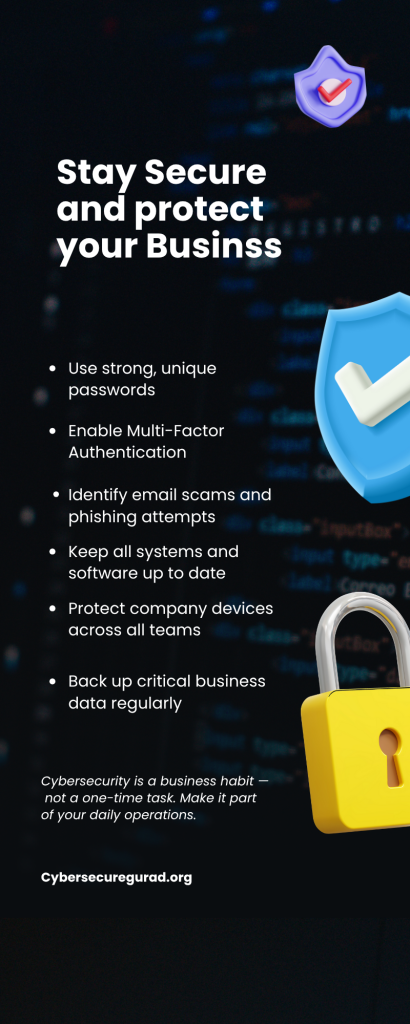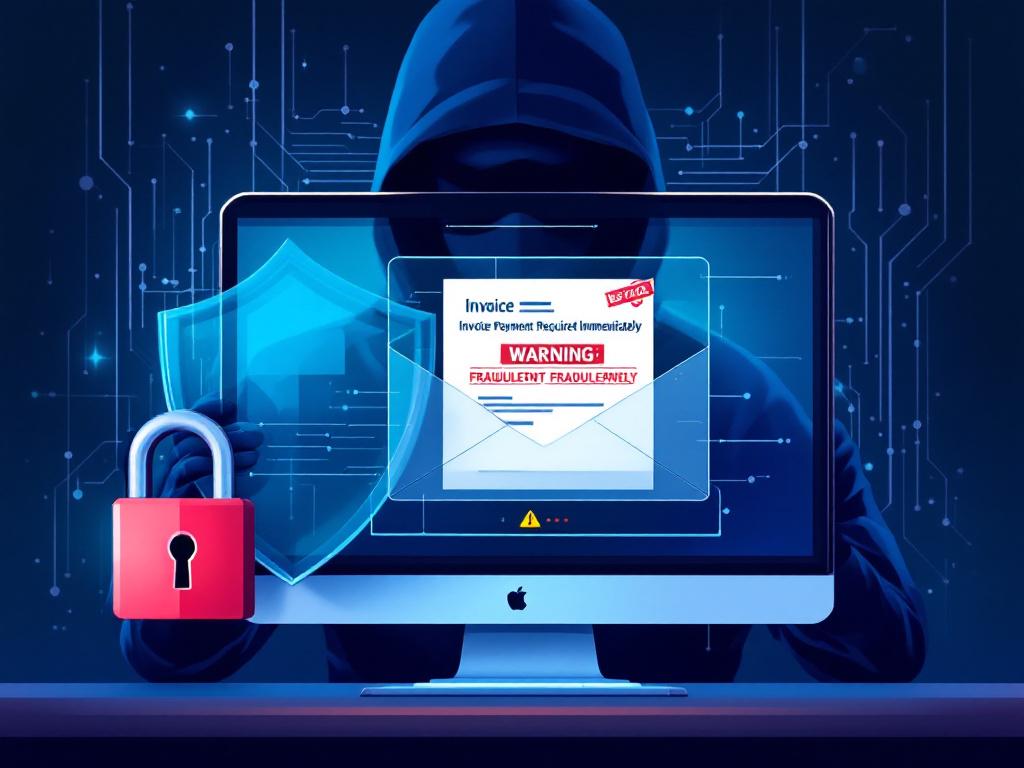Why a Fake Invoice Can Ruin Your Business, find it out in this article. It begins with an email that seems completely ordinary. Your accounting manager sits at her desk with a cup of coffee, working through the morning inbox — dozens of messages, familiar names, everyday routines. Nothing stands out. Then she notices an invoice from a supplier your company actually works with. The logo is exactly right, the formatting flawless, the wording identical to the person she has communicated with for years. Even the invoice number fits perfectly into your usual pattern. There are no typos, no strange attachments, no awkward wording. It is simply a normal business email in every possible way.
She pays it. Five minutes later, she continues with her day, unaware that something has already gone terribly wrong. What she doesn’t know is that attackers have been quietly inside your email communication for days or even weeks. They watched ongoing conversations, learned how your team writes, and patiently waited for the perfect moment to strike. When the opportunity came, they created a fake invoice so convincing that even experienced finance professionals would trust it without hesitation.
By the time the real supplier calls and says, “We never received any payment,” the money is long gone — transferred across borders, split into multiple accounts, and moved in ways that make recovery nearly impossible. This kind of fraud doesn’t rely on malware, hacking tools, or technical genius. It takes only one moment of trust, one familiar-looking message, one routine payment.
And that is exactly why invoice fraud has become one of the most financially devastating and emotionally disruptive threats facing small and medium-sized businesses today.
Why Fake Invoice Fraud Works So Well
Fake invoice fraud is so effective because attackers prepare their moves with a level of precision that feels almost unsettling. Once criminals gain access to a mailbox — often through nothing more than a weak password — they behave like silent observers inside your company. They read ongoing conversations without leaving any trace, learning exactly how your team writes emails, which suppliers you regularly pay, how invoices are formatted, and even the tone specific colleagues tend to use. Instead of acting quickly, they wait patiently, sometimes for several weeks. By the time they finally send their fake invoice, it blends in perfectly with your day-to-day communication. Nothing looks unusual. The message feels familiar. And that familiarity is exactly why employees trust it.
This leads to the second point: recognition. People rarely question things that appear routine. If an email looks like the dozens they handle every month — same supplier name, similar formatting, same tone, same timing — no one stops to wonder whether something might be off. Employees are trained to work efficiently, not suspiciously. In many accounting departments, the priority is to keep payments flowing so that operations continue smoothly. Attackers understand this human behavior better than anyone. They don’t try to stand out; they try to blend in.
Another reason this type of fraud works so well is the choice of payment amount. Criminals intentionally keep invoices within a “comfortable” range — typically between €1,000 and €8,000. These amounts are high enough to make the attack financially worthwhile, yet low enough to avoid triggering internal alarm bells. Many small and medium-sized businesses don’t require additional approval for payments in this range, and the numbers look reasonable when compared to previous invoices. An email requesting €3,200 doesn’t raise suspicion; it simply feels like business as usual.
The final reason invoice fraud is so devastating is the sheer speed at which money moves. Once the transfer leaves your account, it is often impossible to recover. Attackers immediately split the funds across several bank accounts, move the money internationally, convert it into cryptocurrency, or withdraw it entirely. Even if your bank initiates a recall, the chances of success are extremely low unless the incident is reported almost immediately — and fake invoice fraud is typically discovered far too late. By the time someone realizes the real supplier never received the money, the funds are long gone.
Invoice fraud succeeds because it doesn’t look like a cyberattack at all. It looks like everyday business — until the damage has already occurred.
The True Damage to Your Business
The consequences of a fake invoice go far beyond the initial shock of realizing money has been sent to criminals. For many small and medium-sized businesses, even a seemingly “moderate” financial loss can cause serious strain. SMBs often operate on tight margins, and unexpected expenses of €2,000 to €10,000 can disrupt cash flow immediately. Suddenly, planned investments must be postponed, essential purchases are delayed, and in some cases the business struggles to meet its own financial obligations. What looks like a single mistake on paper can create a ripple effect that lasts for months.
But the financial hit is only the beginning. When a fake invoice is paid, the real supplier never receives their money — and this naturally leads to operational problems. Projects slow down or stop entirely because the supplier cannot continue working without the agreed payment. Deadlines shift, internal teams must reschedule tasks, and the overall workflow becomes unstable. What should have been a routine financial process turns into a chain reaction of delays that impacts productivity and revenue.
Another layer of damage is the loss of trust. Business relationships are built on reliability, and a security incident — even one caused by invoice fraud — can create doubts about your company’s internal processes. When partners, suppliers, or clients hear that your organization accidentally transferred money to criminals, they may question how securely you handle sensitive information. In industries where trust and consistency are essential, this reputational harm can be far more damaging than the money lost.
And then there’s the cleanup phase, which is often underestimated. Once a fake invoice is discovered, the internal workload skyrockets. IT teams need to secure compromised inboxes, reset passwords, check forwarding rules, disable suspicious access, and review weeks of email traffic. Finance staff must document the incident, contact the bank, notify the real supplier, and update internal procedures. What could have been prevented with simple verification steps becomes a week-long, stressful recovery process that drains time, energy, and resources across multiple departments.
All these factors combined make invoice fraud one of the most disruptive and costly “silent attacks” a business can experience — precisely because it strikes at the intersection of finances, operations, and trust.
The 5 Most Common Invoice Fraud Scenarios in 2025
Invoice fraud in 2025 is no longer limited to simple phishing emails. Attackers now rely on a sophisticated mix of technical intrusion and psychological manipulation to trick businesses into transferring money directly to them. One of the most common and dangerous methods is email thread hijacking. Criminals gain access to a business email account and remain completely silent in the background. They observe real conversations, learn ongoing projects, and wait patiently until a legitimate invoice is sent. At exactly the right moment, they intervene: they replace the bank details, forward the message, and rely on the fact that the accounting team will see nothing suspicious. After all, it is the original email thread — just with one small but devastating modification.
Another widespread tactic doesn’t require a compromised inbox at all: the use of look-alike domains. Attackers register domains that are almost indistinguishable from those of real suppliers. Instead of “supplier-company.com,” they may use “suppIier-company.com,” where a capital “I” mimics a lowercase “l.” To the human eye, this difference is barely noticeable. The emails look legitimate, the name matches a real business partner, and employees naturally trust what they recognize. In busy work environments, small visual details are rarely double-checked — and attackers count on exactly that.
Equally dangerous are situations where the supplier themselves has been hacked. In these cases, companies receive a perfectly legitimate email from the correct sender — written in the usual tone, with the usual formatting, referencing real conversations. The only thing that’s been altered is the bank account information, which attackers modify inside the compromised supplier mailbox. Because the email is authentic, there are no obvious warning signs. Many businesses discover the fraud only weeks later when the real supplier reports that they never received the payment.
Another rapidly growing threat in 2025 is the misuse of deepfake technology. Criminals now create highly realistic synthetic voices or convincingly forged emails that appear to come directly from the CEO, CFO, or another high-level decision maker. These messages often convey a sense of urgency: “This must be paid immediately — no delays.” Employees are naturally reluctant to question instructions from leadership, especially when presented under time pressure. In companies without clearly defined payment approval processes, these deepfake requests can lead to fraudulent transfers within minutes.
A classic tactic that continues to cause damage is the distribution of fake overdue payment warnings. Here, attackers impersonate well-known service providers or large companies and create pressure by claiming that an invoice is overdue. The threats — account suspension, service interruption, or delays in ongoing operations — trigger stress and urgency. Under this pressure, employees are more likely to click “pay now” without verifying the authenticity of the message. Attackers intentionally exploit this psychological moment of panic.
What all these scenarios have in common is that they do not resemble traditional cyberattacks. They mimic ordinary business processes, exploit predictable daily routines, and rely on the natural way employees work. That is why they appear credible — and why they are so dangerously effective.
How to Protect Your Business – Even Without Technical Knowledge
Protecting your business from fake invoice fraud doesn’t require advanced cybersecurity skills or a dedicated IT department. Many of the most effective defenses are simple routines and habits that any company can implement immediately. One of the most powerful safeguards is a strict verification protocol for every change in bank details. If a supplier suddenly provides a new account number or claims they’ve updated their payment information, that should never be accepted based on an email alone. Attackers specialize in manipulating exactly these messages.
The safest approach is a quick phone call using an official number taken directly from the supplier’s website — not from the email signature, not from a forwarded message, not from WhatsApp. This single step would prevent the majority of invoice fraud incidents.
Another highly effective measure is dual approval for payments above €1,000. The goal isn’t to slow down business processes but to eliminate errors and catch irregularities before money leaves your account. Two people checking an invoice independently can spot inconsistencies far more reliably than one person working under time pressure. Research shows that implementing a four-eye principle reduces payment fraud by up to 70%. For many small businesses, where financial tasks often fall on one single employee, this added oversight is invaluable.
Equally important is training your team, because invoice fraud is primarily a communication problem, not a technical one. Employees need to know which red flags deserve immediate attention. The three most important warning signs are: unusual urgency in payment requests, any change in bank details, and sender addresses that look slightly strange or inconsistent with previous communication. Even a short monthly reminder or a simple checklist can turn an impulsive “just pay it quickly” moment into a conscious verification step.
Since nearly all invoice fraud starts with compromised communication, it is essential to protect your email first. Your inbox is the central hub of your business — contracts, financial discussions, confidential information, supplier communication, everything flows through it. That’s why strong passwords, multi-factor authentication, login alerts, and warnings for unusual sign-in locations are non-negotiable. These measures take only minutes to configure, yet they drastically reduce the chances that attackers gain access in the first place. If they can’t enter your mailbox, they can’t manipulate your invoices.
Finally, using a secure cloud accounting system adds another layer of defense. Modern platforms automatically analyze invoices, flag unusual changes in payment details, and detect patterns that don’t match your historical transactions. They reduce human error and help your team identify inconsistencies long before money is approved. Compared to manual processes, spreadsheets, or email-based workflows, these systems offer a safer, smarter, and more resilient foundation.
None of these steps are complex or expensive — but together, they build a strong protective shield around your financial processes. They stop fraud at the point where it most often succeeds: everyday routine.

If You’ve Already Paid a Fake Invoice
Discovering that your company has paid a fraudulent invoice is a moment no business owner wants to face. The first reaction is usually shock — followed by frustration, worry, and the urgent question: What now?
In solchen Momenten zählt jede Minute. The speed of your response can make the difference between containing the damage and allowing attackers to escalate their access even further.
The very first step is to contact your bank immediately and request a payment recall. Banks can initiate a reversal only if the transfer has not yet been fully processed, and in many cases the window is extremely small — sometimes just minutes. Even if the chance of recovering the full amount is low, taking action right away is essential and gives you the best possible odds.
Next, you should freeze any email accounts that may have been involved in the communication, especially the one used to receive or process the fraudulent invoice. Attackers often maintain access for days or weeks, and leaving the account active could give them the opportunity to manipulate additional messages. Once the account is secured, make sure to change passwords for the entire finance team and any other employees who interacted with the suspicious message. Activating multi-factor authentication at this stage is critical, as it prevents attackers from logging back in.
It’s also important to notify the real supplier as soon as possible. This prevents misunderstandings such as duplicate payments, incorrect follow-ups, or further fraudulent messages. Suppliers can also check their own systems for suspicious activity — especially in cases where their inbox may have been compromised.
Equally crucial is to document every detail of the incident. Record the time of the transfer, screenshots of the fraudulent email, the invoice file, bank transaction details, and all communication with your bank. This documentation is necessary for reporting the incident to authorities, filing insurance claims, and improving internal processes to prevent future attacks.
Even if the money cannot be recovered, your response does not end here. Fraudsters often attempt additional attacks once they know a company has already fallen victim — sometimes within hours. That’s why it’s essential to tighten security immediately: review email rules, check for forwarded messages, confirm no unauthorized access remains, and update internal payment procedures.
The goal now is not only damage control, but also preventing a second, potentially even more costly attack. Acting fast, systematically, and decisively will help your business regain control and rebuild security where attackers tried to exploit trust.
Conclusion – Why a Fake Invoice Can Ruin Your Business
Fake invoices are one of the most dangerous and underestimated threats for small and medium-sized businesses. They don’t rely on advanced hacking tools or complicated malware — they exploit something far simpler: trust, routine, and the natural flow of everyday work. That’s exactly why they cause such serious damage. A single fake invoice can disrupt cash flow, delay projects, harm supplier relationships, and trigger costly recovery work that drains both time and resources.
Understanding why a fake invoice can ruin your business is the first step toward preventing it. The good news is that most attacks can be stopped with straightforward, non-technical measures: clear verification processes, strong email protection, team awareness, and modern accounting tools. These simple actions create a powerful barrier against fraudsters who depend on speed, stress, and familiarity to succeed.
When businesses strengthen their everyday habits, they don’t just protect money — they protect trust, stability, and long-term growth. Invoice fraud may be evolving, but with the right mindset and a few disciplined routines, your organization can stay two steps ahead.
This could also be interesting for you
AI-Phishing Emails: Why They’re Harder to Detect Than Ever
Cybersecurity 2025: The Biggest Risks for Businesses – and How to Protect Your Company
Deepfake fraud in 2025 – How to detect fake voices and videos
Exposing phishing emails: How to recognize fraud attempts – safely and systematically
Follow me on Facebook or Tumblr to stay up to date
Connect with me on LinkedIn
This is what collaboration looks like
Take a look at my cybersecurity email coaching
And for even more valuable tips, sign up for my newsletter





